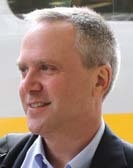
Tom Butts
Editor-in-Chief
tbutts@nbmedia.com
WASHINGTON— “I strongly believe that the interests of the American people are served by a vibrant broadcasting industry,” FCC Chairman Tom Wheeler told NAB Show attendees in April. This is nothing new. FCC chairmen and commissioners are never short with platitudes when it comes to extolling the benefits of broadcasting; unfortunately too often their words come across as lip service. If Chairman Wheeler really believes in what he says, then it’s time for him to back them up.
Take ATSC, for example. We recently got an update from the standards body on progress towards ATSC 3.0, the next-generation broadcasting standard. The continuing work to develop and formalize the standard over the next several years is going to be crucial in determining the future viability of the U.S. broadcasting standard and the association is to be commended on its work to “fast track” the standard.
A week after the ATSC meeting, the FCC released its long-awaited report and order on spectrum incentive auctions. Although the commission stated that it plans to preserve the same viewer coverage as of two years ago, it also advocated using the flawed “TVStudy” software instead of previous methods.
The FCC also is ignoring another opportunity to ensure that the upcoming spectrum auctions take advantage of advances in broadcast standards. Coordinating the spectrum auction schedule with the development of the ATSC 3.0 standard could help resolve a number of issues that prevent more broadcasters from participating in the voluntary auction as well as ease the transition for consumers. This view, advocated by industry veteran Jay Adrick, would not only create less disruption in the broadcast marketplace, it’s also possible because of the Congressionally mandated schedule that the auction process be completed by 2022.
Adrick says that despite the commission’s intent to base a station’s transition timeline after spectrum repack on the “complexity” of the transition, “we know that’s not going to work.”
“That’s what they think they’re going to do,” Adrick said. “But it’s going to cause confusion in the marketplace for those people who view over-the-air. You’re going to see stations drop out of the scan and viewers will have to re-scan. Then, if we transition to 3.0 later, we’re going to have a repeat of all this.”
The professional video industry's #1 source for news, trends and product and tech information. Sign up below.
One of the broadcast industry’s major issues with the FCC’s implementation of the auction is that stations are hesitant to participate unless they know what their future coverage will be, as well as the consequences of moving to new channels. In short, they need more answers.
Add to this the potential of channel sharing and the advantages of using the ATSC 3.0’s bandwidth of 26 Mbps as opposed to the current standard’s 19 Mbps pipe and it’s obvious that a coordinated effort would be beneficial to all players involved, especially if the commission wants more stations to voluntarily participate.
One FCC official publicly rejected the idea of a coordinated effort at last year’s ATSC meeting, according to Adrick, but with NAB President Gordon Smith’s call at the NAB Show for a “National Broadcast Plan,” perhaps it’s time for the Chairman to “walk the talk” when it comes to advocating the future of television broadcasting.
Tom has covered the broadcast technology market for the past 25 years, including three years handling member communications for the National Association of Broadcasters followed by a year as editor of Video Technology News and DTV Business executive newsletters for Phillips Publishing. In 1999 he launched digitalbroadcasting.com for internet B2B portal Verticalnet. He is also a charter member of the CTA's Academy of Digital TV Pioneers. Since 2001, he has been editor-in-chief of TV Tech (www.tvtech.com), the leading source of news and information on broadcast and related media technology and is a frequent contributor and moderator to the brand’s Tech Leadership events.

